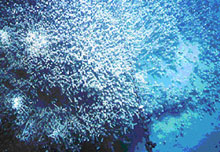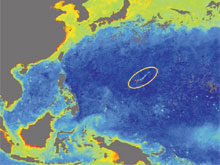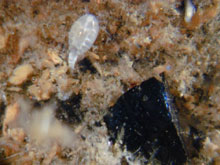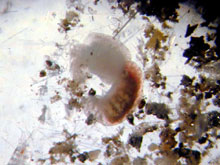
The tubeworm Lamellibrachia satsuma occurs on Nikko Seamount at the northern end of the arc. Click image for larger view.
Biological Studies 2004
Verena Tunnicliffe
Canada Research Chair in Deep Oceans
Professor, University of Victoria, Canada
The opportunity to explore the oceans in a distant chain of subsea volcanoes is irresistible. How can we plan for biological work in a location and a setting that are nearly unknown? We are building our study plans around three pieces of information: (1) prior biological work in the area; (2) known geological and chemical conditions; and (3) experience on similar systems elsewhere in the world. In addition, we try to optimize our results by meshing biological work with geological and chemical studies.
What lives at vents on the Mariana Arc?
Several research cruises have examined the biota in this area, although the information is limited. The submersibles Shinkai and Alvin have conducted dives in the Mariana Trough. There, in vent fields between 1,500 and 4,000 m depth, they found dense communities of shrimp, crabs, anemones and large snails. On the northernmost volcanoes of the arc, Japanese workers found crabs, barnacles, mussels and vestimentiferans (a type of deep-sea tubeworm). Thus, we expect to find dense vent assemblages, but we cannot predict which organisms will dominate.
A major part of the investigation will be visual documentation of the fauna. The imagery from geological traverses will provide an excellent overview. The remotely operated vehicle (ROV) ROPOS has a fine video camera to provide consistent transect information for later analysis. In addition, we will use the digital still camera to examine the small organisms within active vent areas. We will document animal composition at the same places where the chemists extract water samples.
What are they eating?
These vents are some of the shallowest known in the world. Which food source is more important, chemosynthetic bacteria at the vents or photosynthetic plankton at the surface? Examination of carbon isotopes and lipid composition in vent animals will reveal clues to their dietary components. We will also look at the smallest members of the vent food chain, the bacteria and the "meiofauna" -- animals such as tiny worms and the miniscule crustaceans known as copepods and ostracods. Even the detritus (debris) from vent samples has a story to tell. We will examine its composition to determine how organic matter is being recycled at the vents.
Islands in the Stream?
Most vent animals produce larvae that are released into the water and drift with the currents. We know little about how far they go or how they find vent sites. However, such larvae are key to colonizing new sites and to genetic diversity in the population. We will conduct several studies designed to examine the transport of larvae. Plankton nets attached to ROPOS will collect larvae to determine where they concentrate. Another method to investigate how populations on different seamounts interact through larval transport is to examine the genetic structure among individuals at each site. We will collect a species common to most sites and examine its “gene flow” back on shore.

SEAWIFS ocean color in May 2003. The circled red dot is Anatahan Volcano. A streak of color drifts to the northeast. Click image for a larger view.
Volcanoes and Plankton Growth
The Mariana Arc seamount
chain is a great place to examine how the volcanoes influence the production
of organisms in the water column. Through net tows and water samples, we
can investigate the amount of plankton over venting and nonventing volcanoes.
Nutrients such as iron that are expelled from volcanoes may enhance local
phytoplankton. After the eruption of Anatahan in 2003, a SEAWIFS satellite
revealed changes in water color, probably due to currents sweeping phytoplankton
off the volcano where high growth occurred. We will take samples to test
this idea. The comparison of zooplankton near and far from the volcanoes
will also provide information on whether the island arc is concentrating
production that may feed into upper trophic (i.e., top food chain) levels.





























